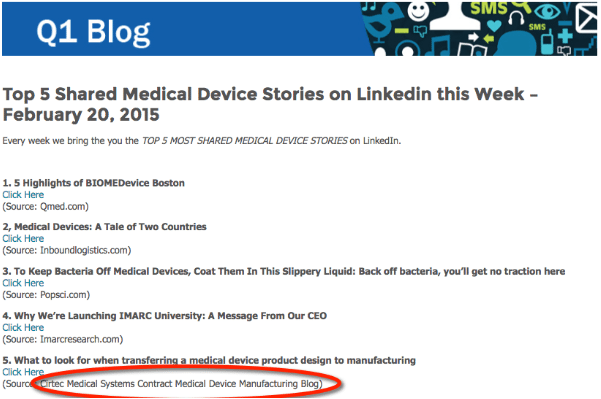There are lots of reasons to blog. SEO is the most common reason—companies start blogs to get found by the people searching for the kinds of solutions they offer. Another reason to blog is to establish a company as a thought leader—to be perceived as a leader in your industry. Thought leadership can be extremely valuable to building a new company and a new brand. Here are some tips for blogging for thought leadership.
1) Talk about problems, not your company. We wrote an article for a medical device manufacturer that specialized in packaging and sterilization for medical devices makers. I learned that this step, what some consider the last mile in the manufacturing process, is often overlooked as companies rush new products to market. A little research uncovered some alarming numbers of recalls due to packaging and sterilization issues. So we wrote an article about best practices in packaging and sterilization. After the article was published, we received an email from a professor of medical device manufacturing at one of the University of California schools asking if he could use it in his medical device manufacturing course.
2) Don’t mention your company name. A blog we wrote for a manufacturing equipment maker focused only on advances in technology in its industry. We never mentioned the company or product name. After a few months, the company’s blog was cited in the largest trade publication in our space as “really getting the word out” about the technology and the industry
 3) Use LinkedIn Groups. I am a tireless promoter of LinkedIn Groups. Used properly, they can be a tremendous source of thought leadership. Sharing educational articles, asking genuine questions, responding to others with honest feedback, can help you build a following and win the respect and trust of your peers. Many LinkedIn Groups are very narrowly focused. There are dozens, for example, in the area of medical device manufacturing and sub-categories like cardiac medical devices, implantable medical devices, clinical research for medical devices, and more. It is important not to use these forums for promotional purposes. Most moderators reject promotional content. One company we worked with found LinkedIn Group engagement resulted in LinkedIn being the second largest source or web traffic after Google.
3) Use LinkedIn Groups. I am a tireless promoter of LinkedIn Groups. Used properly, they can be a tremendous source of thought leadership. Sharing educational articles, asking genuine questions, responding to others with honest feedback, can help you build a following and win the respect and trust of your peers. Many LinkedIn Groups are very narrowly focused. There are dozens, for example, in the area of medical device manufacturing and sub-categories like cardiac medical devices, implantable medical devices, clinical research for medical devices, and more. It is important not to use these forums for promotional purposes. Most moderators reject promotional content. One company we worked with found LinkedIn Group engagement resulted in LinkedIn being the second largest source or web traffic after Google.
 4) Submit articles for publication. Many trade publications, especially those that are online-only, are hungry for content. They will, in many cases, link to blog posts and publish other content like white papers and cases studies. These are great sources of authority in your industry. We sent a blog post about manufacturing equipment advances to a trade publication and it led to a feature story on the topic.
4) Submit articles for publication. Many trade publications, especially those that are online-only, are hungry for content. They will, in many cases, link to blog posts and publish other content like white papers and cases studies. These are great sources of authority in your industry. We sent a blog post about manufacturing equipment advances to a trade publication and it led to a feature story on the topic.

5) Help, don’t sell. This is sort of inbound marketing 101, but it is also thought leadership 101. People aren’t online, especially in B2B businesses, looking for a sales pitch. They are looking for help with a problem they are having. Great content helps them confirm that their problem is real, explore various solutions, and find the right solution for them. Blog to help and you will find people come back for more because you’ve built a measure of trust and credibility by not trying to sell them from the start.

Thought leadership—being perceived as an expert in your field and in your industry can be an extremely valuable source of credibility and trust for your company and your brand. Your blog can be a source of thought leadership if written and promoted using these guidelines.




